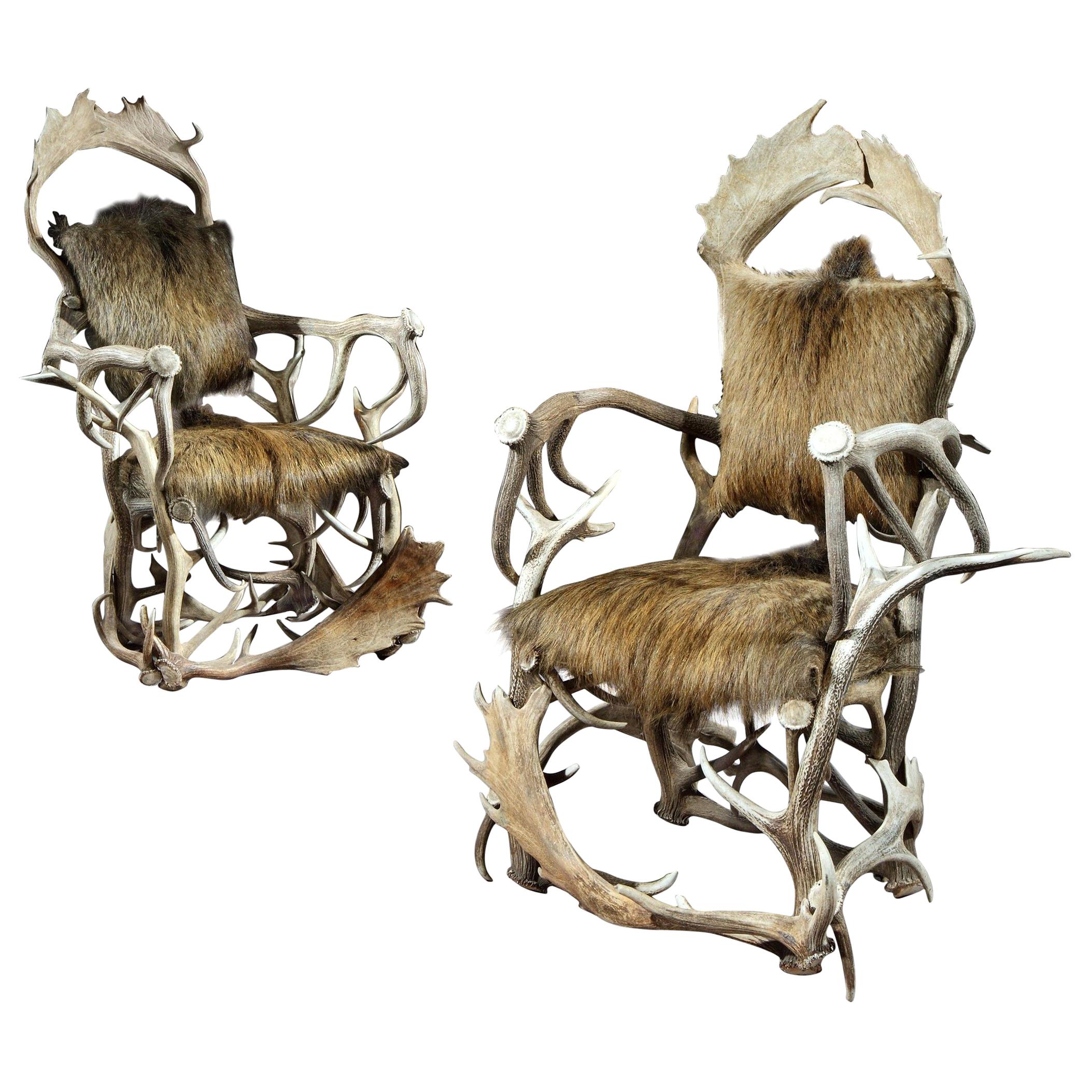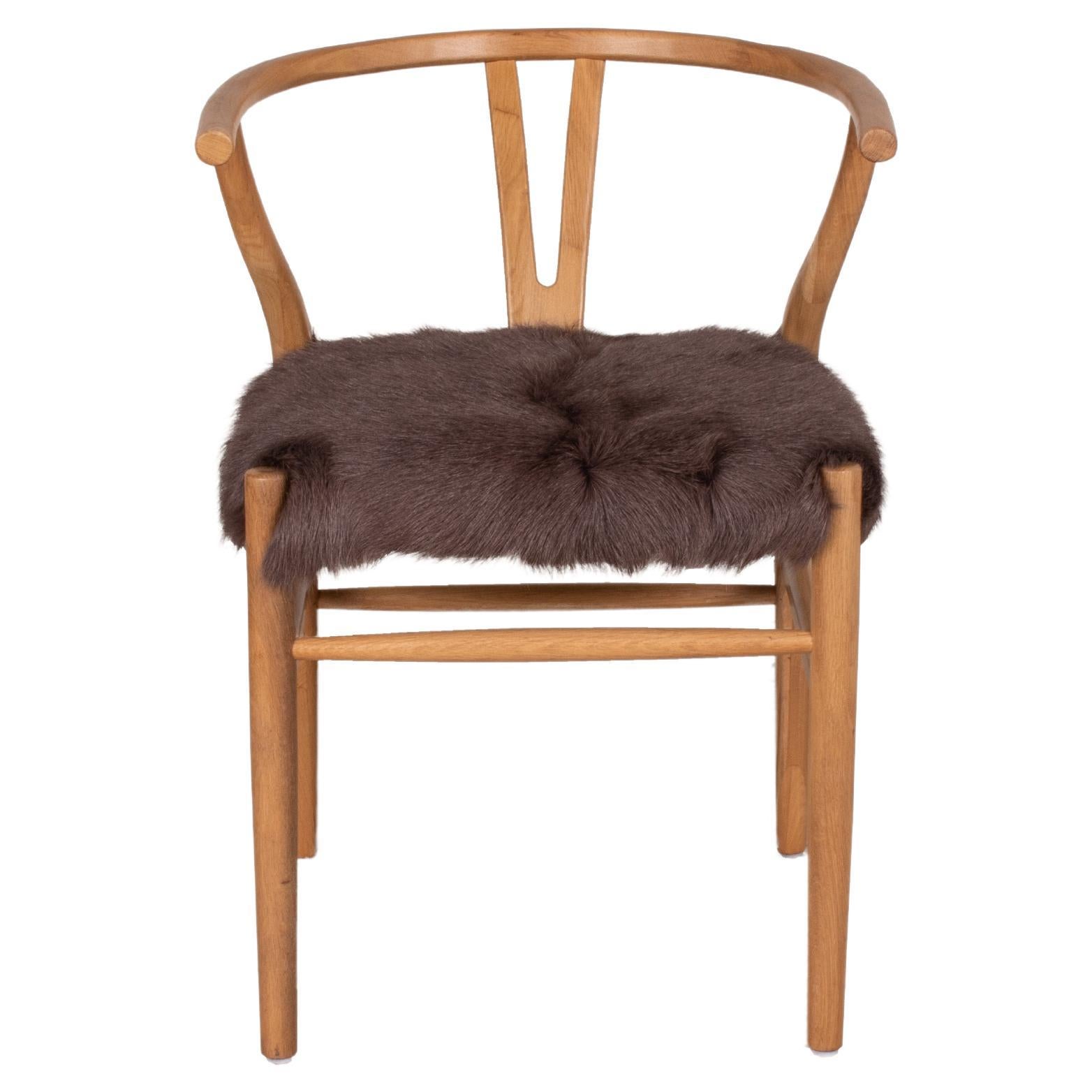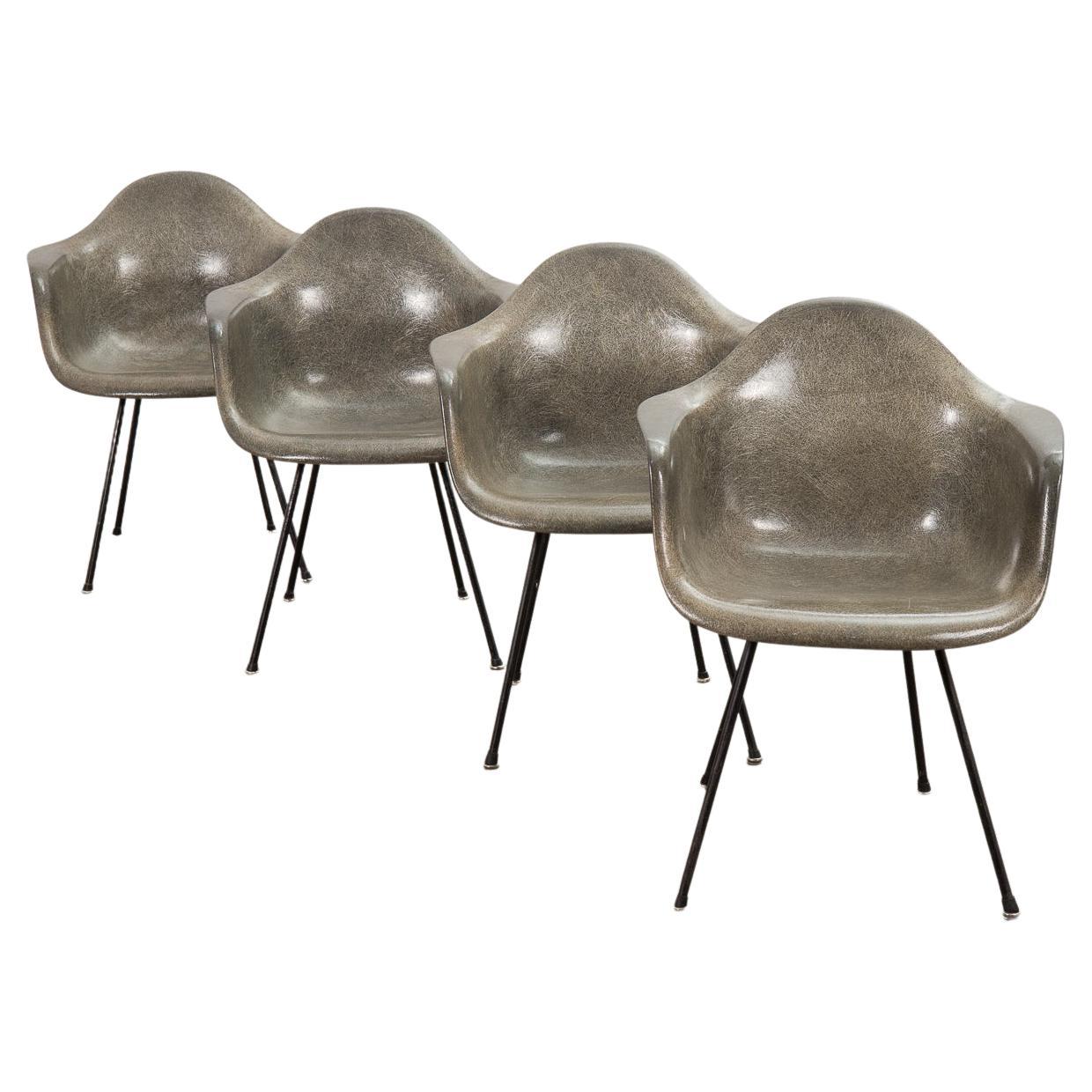Items Similar to Armchair, Hunting Trophy, Antler, Red Deer, Fallow, Wild Boar, Hide
Want more images or videos?
Request additional images or videos from the seller
1 of 21
Armchair, Hunting Trophy, Antler, Red Deer, Fallow, Wild Boar, Hide
About the Item
Hunting trophy armchair of antlers, wild boar and red deer. Very expressive and impressive looking throne
The fluid form of the antlers creates a sculptural, organic aesthetic.
Next to that this chair is usable and comfortable. It has taken great skill to make these chairs, selecting massive antlers to create exquisite form and stability within a minimalistic, sculptural aesthetic.
The impressive crestings, sides and front stretchers on each armchair are made from five magnificent fallow deer antlers. The arms and supports on each chair are made from massive red deer antlers. The antlers are arranged creatively to create both, a stable structure and sculptural form. The seats are upholstered in wild boar hide.
Measurements: h 146, d 95, w 135 cm
Seating height 47 cm
Museums With Collections of Antler Furniture:
• Victoria & Albert Museum, London
• Museum casle trautenfels, Trautenfels – Austria
• Museum of natural history, Venice
• Palace Museum, Beijing
“There is grace and movement in the antler itself. They’re one of the most beautiful forms in nature…” Gail Flynn
Hunting trophies have been used as source material for clothes hooks, storage racks and lamps since the 15th century. Mounting antlers and stuffed heads on walls provided impressive, decorative displays for hunting trophies. A hunting lodge replete with antlers and stuffed animals was most likely where ideas for antler furnishings emerged.
At the beginning of the 19th century antler furniture was made exclusively for the European nobility to decorate palaces, castles and country seats. The furniture was either made completely from stag antler, or it was decorated with antler pieces from the stag, deer, fallow deer and others, or veneered with sliced antler pieces to create a hunting design.
The first recorded antler furniture dates from 1825, made for a hunting castle of Count William of Nassau near Wiesbaden, Germany. Other famous collections of historical antler furniture are the hunting room in the country estate of the brandhof of Archduke Johann of Austria or the antler collection of Count Arco in his palace in Munich, Germany. There are hundreds of drawings of creative antler decorations by the Austrian furniture maker Joseph Danhauser (1780-1829).
In 1851, chairs, chests of drawers and a sofa made of horns were exhibited at the Great Exhibition Of The Industries Of All Nations in London which were considered one of the great novelties of this iconic exhibition. This created a new lifestyle trend and fashion driven by the ambitious European middle-class and antler furniture disseminated into bourgeoisie households. One of the first designers is the German ivory carver and furniture maker H. F. C. Rampendahl who gained enthusiastic successes on several world exhibitions with his antler furniture. An antler bureau, a horn seating group or individual chairs, decorated gun cabinets, H.F.C. Rampendahl created a whole new design world for fashioning rooms. This prompted other designers in Germany Austria and USA to make antler furniture H.F.C. Rampendahl, Hamburg, P. Keutner, Regensburg, Vitus Madel & Son, Ichenhausen, Kurt Schicker, Regensburg, Heinrich Keitel, Vienna, Rudolf Brix, Vienna, Friedrich Wenzel, San Antonio. These are some of the most important manufacturers of antler furniture and their range covered the whole market of furniture as well as smaller pieces. Their catalogues feature antler furnishings (Geweihmöbel) like antler gun racks, antler chandeliers, antler-frames, antler chairs, lusterweibchen, antler cabinets as well as small decorative items like desk sets, humidors, wardrobes, cutlery, etc..
The last decade has seen a revival in the popularity of antler furniture. Its iconic, natural organic style creates a striking focal point in modern households as well as eye-catchers for hunting lodges and chalets in mountain areas. The flowing sculptural form of antlers retain the grace, agility and presence of the animals that they came from.
Provenance: Private Collection
Literature: • Georg Olms: August Stukenbrok Illustrierter Hauptkatalog. Olmspresse, Hildesheim 1972
• Sabine Spindler: Geweihmöbel 1825-1925. Klaus Spindler, München 2006
• Bruce M. Newman: Fantasy Furniture. Rizzoli, New York 1989
• Christopher Payne: 19th CENTURY EUROPEAN FURNITURE Antique Collectors´ Club, England 1981
• Rainer Haaff: Prachtvolle Stilmöbel Kunst-Verlag-Haaff 2012
• Richard St.John, Longhorn Artist: Wenzel, Friedrich (Wichita State University Office of Research and Sponsored Programs, 1982).
- Dimensions:Height: 57.49 in (146 cm)Width: 53.15 in (135 cm)Depth: 37.41 in (95 cm)Seat Height: 18.51 in (47 cm)
- Style:Black Forest (In the Style Of)
- Materials and Techniques:
- Place of Origin:
- Period:
- Date of Manufacture:Unknown
- Condition:
- Seller Location:Zevenaar, NL
- Reference Number:1stDibs: LU9519239637922
About the Seller
New to 1stDibs
Joined in the past six months.
No Reviews Yet
Vetted Seller
These experienced sellers undergo a comprehensive evaluation by our team of in-house experts.
1stDibs seller since 2023
5 sales on 1stDibs
Typical response time: <1 hour
- ShippingRetrieving quote...Ships From: Zevenaar, Netherlands
- Return PolicyA return for this item may be initiated within 14 days of delivery.
More From This SellerView All
- Egon Eiermann for Wilde & Spieth, SE68 Bauhaus chair set of 13By Wilde + Spieth, Egon EiermannLocated in Zevenaar, NLStackable SE68 Chair by German architect Egon Eiermann for Wilde & Spieth in red. Designed in 1952. Ergonomic & organically shaped beech plywood seat and backrest, frame made of chr...Category
Vintage 1950s German Bauhaus Chairs
MaterialsMetal
- Black leather dining net chairs by Giancarlo Vegni for Fasem ItalyBy Giancarlo VegniLocated in Zevenaar, NLSet of 4 Italian Lounge dining chairs also called Net chair with steel steel structure, original laquered in grey and continuous seat/back made of interlaced stripes of full grain hi...Category
20th Century Italian Chairs
MaterialsMetal
- Knud Friis & Elmar Moltke Nielsen (Friis & Moltke) pine brutalist chairs GetamaBy Knud Friis & Elmar Moltke NielsenLocated in Zevenaar, NLSet of two very rare comfort Solid Wood Chairs by Brutalist architects Knud Friis and Elmar Moltke Nielsen. Denmark 1970s. Handmade bent...Category
Mid-20th Century Brutalist Chairs
MaterialsPine, Plywood
- Violin dining or sidechairs by Maroeshka Metz, Dutch pomo design, 1980sLocated in Zevenaar, NLDutch designer Maroeska Metz was educated as a sculptor at Gerrit Rietveld Academy Amsterdam. Characteristic of her works is that all her works are swirl...Category
Vintage 1980s Dutch Post-Modern Chairs
MaterialsSteel
- Bauhaus cantilever dining chairs with arms loopin black leather by FasemBy Mart Stam, Marcel Breuer, Fasem InternationalLocated in Zevenaar, NLSet 5 "S34" Mart Stam tubular frame chairs, Fasem Italy How timeless something can be! This design by Mart Stam is originally from the 1920s and completely modern untill today. Thes...Category
20th Century Italian Bauhaus Chairs
MaterialsSteel, Chrome
- Large round red velvet tower sofa by EdraBy EdraLocated in Zevenaar, NLThis red velvet Tatlin sofa was designed by Mario Cananzi and Roberto Semprini for Edra in the 1980s. Inspired by the famous Tatlin tower, a symbol of constructivism created by Vladimir Tatlin. This sofa is upholstered in its original red velvet. It might need new new upholstery because it has some spots and decoloration. The inside is still in good condition. Please check the pictures. 135cm H x 210cm W x 175cm D seating height: 38 cm This wild and amazing Postmodern 'Tatlin' center sofa was designed by Mario Cananzi and Roberto Semprini and produced by Edra in 2002. Covered in a sumptuous red velvet fabric over a steel and wood frame, this high quality and substantially sized circular settee...Category
21st Century and Contemporary Italian Sofas
MaterialsSteel
You May Also Like
- Armchair, Pair, Hunting Trophy, Antler, Red Deer, Fallow, Wild Boar, HideLocated in BUNGAY, SUFFOLKPairs of hunting trophy armchairs are exceptionally rare. This pair are also unusual because they are made from a few large antlers giving them a minimalist quality. The fluid form of the antlers creates a sculptural, organic aesthetic. They are also usable and very comfortable. It has taken great skill to make these chairs, selecting massive antlers to create exquisite form and stability within a minimalistic, sculptural aesthetic. They are dramatic and unusual injecting a naturalistic and organic gravitas to any interior which reflects the grace, agility and presence of the kings of forest that they came from. The impressive crestings, sides and front stretchers on each armchair are made from five magnificent fallow deer antlers. The arms and supports on each chair are made from eight massive red deer antlers. The antlers are arranged creatively to create both, a stable structure and sculptural form. The seats are upholstered in wild boar hide. Dimensions: Width 91cm., 35.83in., Height 132cm., 51.97in., Depth 96cm., 37.80in. Museums With Collections Of Antler Furniture • Victoria & Albert Museum, London • Museum casle trautenfels, Trautenfels – Austria • Museum of natural history, Venice • Palace Museum, Beijing “There is grace and movement in the antler itself. They’re one of the most beautiful forms in nature…” Gail Flynn Hunting trophies have been used as source material for clothes hooks, storage racks and lamps since the 15th century. Mounting antlers and stuffed heads on walls provided impressive, decorative displays for hunting trophies. A hunting lodge replete with antlers and stuffed animals was most likely where ideas for antler furnishings emerged. At the beginning of the 19th century antler furniture was made exclusively for the European nobility to decorate palaces, castles and country seats. The furniture was either made completely from stag antler, or it was decorated with antler pieces from the stag, deer, fallow deer and others, or veneered with sliced antler pieces to create a hunting design. The first recorded antler furniture dates from 1825, made for a hunting castle of Count William of Nassau near Wiesbaden, Germany. Other famous collections of historical antler furniture are the hunting room in the country estate of the brandhof of Archduke Johann of Austria or the antler collection of Count Arco in his palace in Munich, Germany. There are hundreds of drawings of creative antler decorations by the Austrian furniture maker Joseph Danhauser (1780-1829). In 1851, chairs, chests of drawers and a sofa made of horns were exhibited at the Great Exhibition Of The Industries Of All Nations in London which were considered one of the great novelties of this iconic exhibition. This created a new lifestyle trend and fashion driven by the ambitious European middle-class and antler furniture disseminated into bourgeoisie households. One of the first designers is the German ivory carver and furniture maker H. F. C. Rampendahl who gained enthusiastic successes on several world exhibitions with his antler furniture. An antler bureau, a horn seating group or individual chairs, decorated gun cabinets, H.F.C. Rampendahl created a whole new design world for fashioning rooms. This prompted other designers in Germany Austria and USA to make antler furniture H.F.C. Rampendahl, Hamburg, P. Keutner, Regensburg, Vitus Madel & Son, Ichenhausen, Kurt Schicker, Regensburg, Heinrich Keitel, Vienna, Rudolf Brix...Category
Antique Late 19th Century European Victorian Armchairs
MaterialsAntler, Hide
- Bent Wood Armchair with Hide SeatLocated in Dallas, TXBentwood armchair with hide seat.Category
Mid-20th Century French Modern Chairs
MaterialsWood
- Pair of Modern Horn and Antler ArmchairsLocated in Palm Beach, FLPair of Mid-Century chairs constructed of antlers and long horns in a surprisingly comfortable and stylish way. One upholstered in fur and the other in suede, both chairs are sturdy ...Category
20th Century American Organic Modern Armchairs
MaterialsHorn
- Eames Elephant Hide Gray Zenith Rope Edge ArmchairBy Charles and Ray Eames, Zenith, Herman MillerLocated in Brooklyn, NYSet of four early, 1st generation Zenith rope-edge armchairs, designed by Ray and Charles Eames for Herman Miller. In an uncommon and highly desirable elephant hide...Category
Vintage 1950s Mid-Century Modern Chairs
MaterialsFiberglass
- Original Hide Regency Chesterfield Brown Leather Library Reading ArmchairBy ChesterfieldLocated in GBWe are delighted to offer for sale this lovely original Regency circa 1810-1820 Chesterfield distressed leather library reading armchair...Category
Antique 1810s English Regency Armchairs
MaterialsLeather
- Modern Black Hide-Upholstered Armchair with Blackened Oak FrameBy Mar SilverLocated in Westport, CTAn elegant blackened oak armchair upholstered in black hide evokes clean mid-century lines while providing a relaxing seating experience. The striking hide upholstery provides textur...Category
2010s American Mid-Century Modern Armchairs
MaterialsHide, Walnut, Oak





